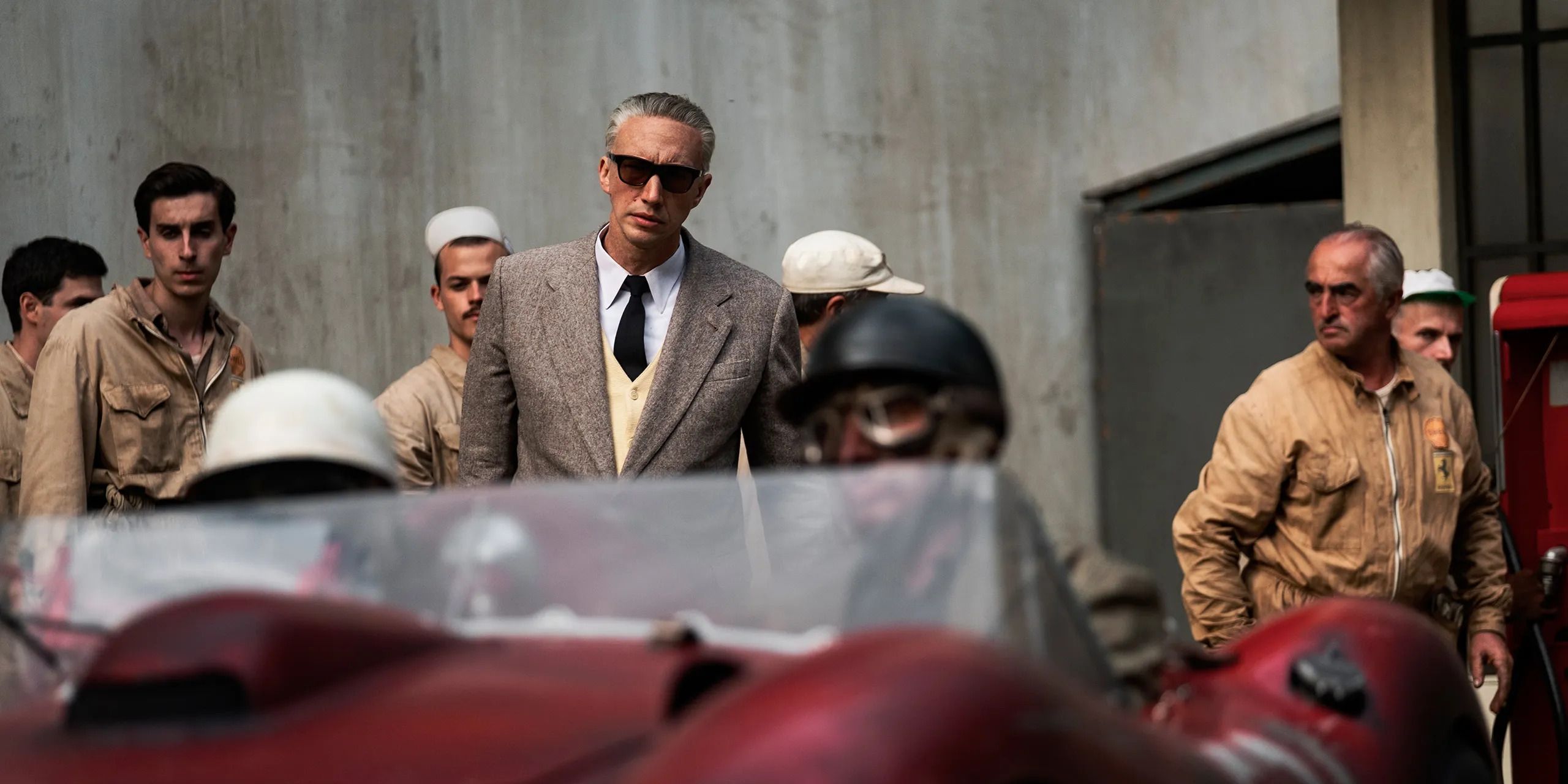Michael Mann gets quite a bit right about Ferrari, both the man and the machine.
The Big Picture
- Michael Mann takes a focused approach to Enzo Ferrari’s life in 1957, highlighting his personal and professional struggles with precision.
- The film uses real events but shifts timelines for dramatic effect, maintaining authenticity in central plot points and character relationships.
- Authenticity shines in portraying Enzo’s life and auto racing, with period-accurate cars and thrilling sequences capturing the spirit of Ferrari.
With his first movie in nearly a decade, Michael Mann finally saw his long-gestating Enzo Ferrari biopic race onto screens in December 2023. Ferrari stars Adam Driver in the title role, covering many personal and professional events in Ferrari’s life during the summer of 1957. Mann is no stranger to telling true-to-life stories, with heavy research and effort put into a style that promotes an immersive experience. Mann’s films reflect real-world experiences, even when they are telling fictional stories. However, Ferrari is not his first time adapting real-world events. In 1999 and 2009 respectively, Mann covered a tobacco industry cover-up with The Insider and the waning days of Depression-era bank robberies with Public Enemies. In between, Mann also directed another more straightforward biographical drama, Ali, which similarly sought to showcase not only Ali’s public life and professional achievements, but also his internal struggles.
Ferrari is at once a melodrama and a high-speed thrill ride, with racing sequences that are stunning and intense dialogue scenes that are just as exhilarating. The movie offers a slew of great performances, including Driver and Penélope Cruz, who portrays Laura Ferrari with a fiery resolve that nearly steals the entire movie. Largely playing off of Brock Yates’ 1991 biography, Enzo Ferrari: The Man and The Machine, Mann draws from a rich, tragic history for a compelling, stylish late-period masterpiece that follows through on evergreen themes in his filmography such as masculinity, emotional detachment, technology, and perfectionism. But how closely does the film follow the life of Enzo Ferrari? ‘

Ferrari
Set in the summer of 1957, with Enzo Ferrari’s auto empire in crisis, the ex-racer turned entrepreneur pushes himself and his drivers to the edge as they launch into the Mille Miglia, a treacherous 1,000-mile race across Italy.
- Release Date
- December 25, 2023
- Director
- Michael Mann
- Cast
- Shailene Woodley , Adam Driver , Sarah Gadon , Penelope Cruz
- Runtime
- 130 minutes
Michael Mann Uses a Narrow Slice of History to Examine What Drives Enzo Ferrari
Biopics that take a cradle-to-grave approach often bite off a bit more than they can chew.Ferrari avoids this problem by narrowing the scope to the summer of 1957. The movie, utilizing only a few flashbacks that take us out of this time, can dig into Ferrari’s inner drive, his vices, and his professional and personal struggles with great precision. In an interview with The Ringer ahead of the release of the film, Mann explained: “The only reason this had viability for me was because of the unique history of Enzo Ferrari, that happened to be three months in 1957 in which there’s so many tempestuous, operatic events occurring in his private, intimate life.”
This narrow slice of Ferrari’s life saw him imprisoned by the compounding grief of his son’s death the year prior, and the continued toll that many fatal car accidents had on his drivers, company, and personal reputation. At this time, Ferrari is also caught in a struggle between his failing marriage to Laura and his affair with Lina Lardi (Shailene Woodley), which results in a child whom he cannot publicly acknowledge. All of this is accurate to Enzo’s real personal life. Laura and Enzo struggled to reconcile their mounting tensions in the wake of their son’s death, and while it was an open secret around Modena (where the film was shot on location) that Enzo had a second family, he had not divulged this information to Laura.
Laura, despite their difficult relationship, was a key figure in the success of Ferrari as a racing company.Per a Deadline panel in promotion of the film, Mann revealed that it came up during his research that Laura sold off a wedding gift to cover the deposit for the building of Ferrari’s first car. While Enzo focused on the cars, and operated as the enigmatic face of the company, with his unusual relationship with the press depicted quite hilariously in the film, Laura ran the business like clockwork.
Aside from Ferrari’s family life, the major centerpiece of the film is the 1957 Mille Miglia, a nearly thousand-mile race through town squares and residential streets across Italy. This was the last time the Mille Miglia would run because, as depicted in a heart-stopping, sobering fashion in the film, young Ferrari driver Alfonso de Portago suffered a blow-out crash that claimed the lives of 11 people. De Portago, his navigator, and nine spectators died in this accident. Mann went to great lengths to depict the crash realistically, while also respecting the nature of the tragedy.
During a visit to the crash site, Mann had a happenstance meeting with an older man whose nine-year-old brother died in the crash when he was three years old. This witness’s story was added to the film, when the perspective shifts to a family running out to watch the cars shortly before the tragic accident. While Mann’s films often pack a lot of style, the quiet, reverential, and subdued manner in which the crash is depicted appropriately sets the tone for how devastating a moment it was for Italy and the racing world. It is a haunting recreation of the terrible consequences of what Enzo, in one of the film’s best dialogue scenes, refers to as “our deadly passion, our terrible joy.”
‘Ferrari’ Shifts Events Around, But Remains Largely True to the Personal and Professional Turmoil
As with any biographical or based-on-a-true-story work, Ferrari takes creative liberties for the sake of storytelling efficiency and dramatic impact.Ferrari is an example of a movie that largely sticks to the reality of what occurred, which is no surprise considering that Mann is about as detail-oriented and meticulous as Ferrari himself. What the film does get “wrong” is less about fabrications and more about how certain events relate to one another chronologically.
The film plays with the timeline of events for the sake of raising the stakes of the drama. The major bend in the comparison between Ferrari and the real-world history depicted is that Ferrari was not at serious risk of being bought out or shut down during the time depicted in the film. Ferrari indeed ran into financial troubles, and a large chunk of the company was acquired by Fiat, but that did not happen until the late 1960s, yet the film imagines Ferrari’s dire financial state as a pressing issue in 1957. This choice raises the stakes of Ferrari’s performance in the Mille Miglia, creating an even more complicated feeling for Ferrari after Pierro Taruffi (Patrick Dempsey) secured a victory amid the fatal accident.

The Heartbreaking True Story Behind the Mille Miglia Crash in ‘Ferrari’
How deadly was the crash in real life?
The events that are played with for the sake of the narrative are not entirely fabricated, but either rearranged or born out of common speculations from the time, such as one depicted toward the end of the movie where Laura makes Enzo promise not to give his illegitimate son the Ferrari name while she is alive. Indeed, Enzo did not acknowledge the boy until after her death in the 1970s. Laura was known to have felt embarrassment at the idea of Enzo acknowledging his second family, but the promise itself is not documented as definitely having happened. Italy’s strict laws regarding marriage at the time would have prevented Enzo from giving the boy the Ferrari name.
Since Ferrari largely focuses on the events surrounding the Mille Miglia, and his difficulties with his marriage to Laura, the film’s most important plot points are, for the most part, true to life. The film makes some choices for the sake of story efficiency, but largely sticks to the truth when depicting Enzo’s life at home and the racetrack.
‘Ferrari’ Captures the Spirit of Its Subject, and the Deadly Thrill of Auto Racing
Ferrari does a decent job of not straying too far from the actual events that are central to Enzo’s life during 1957. However, the narrative elements are not the only place where authenticity is prioritized. Mann ensured that the cars were all period-accurate, or replicas of period-accurate ones that could be used for the crash sequences. The stunt coordinator for the film, Robert Nagle, also worked on Baby Driver and Ford v. Ferrari. In an interview with Car and Driver, Nagle talked about how the replicas they used for Ferrari moved faster and handled like real race cars, compared to the less authentic cars that are typically used as fodder for stunt sequences. The high speeds and tight turns are all captured in reality.
Dempsey, who is himself a race car driver and performed most of his driving in the film, explained in an interview with Hagerty that it was the “closest feeling” to the real experience in a movie. Mann’s film offers a uniquely grounded vision of a racetrack, while most racing films tend to take a hyper-stylized, ultra-cinematic approach. Ferrari makes you feel like you are in the car. One repeated camera move that is unique to Ferrari essentially acts as a dolly-zoom filmed at 100 miles per hour, creating a dizzying effect like you’re racing into hyperspace.
Enzo Ferrari is a titanic force in the racing industry, and the tall order of encapsulating his life, and his impact on the world of auto-racing, into a single movie is fulfilled by Mann’s vision. Driver finds Enzo in a vulnerable place, pushing himself further and harder while the walls close in around him. Like many Mann protagonists, Enzo is deeply sensitive but masked as emotionally hollow, broken by a world that forces him to be cold and harsh in the face of tragedy and mounting pressures. The film captures his creative spirit and passion for his craft remarkably well, while aptly exploring how tortured he was by his personal and professional failings. With a knockout lead performance, a script that is true to its subject’s life, and Mann working tirelessly to nail the most minute details of the racing world, Ferrari is a more authentic and compelling biopic than most, and a great return from the seasoned director.
Ferrari is available to rent on Amazon in the U.S.
Rent on Amazon
This article was originally published on collider.com



